
Caryodendron is a plant genus of the family Euphorbiaceae first described as a genus in 1860. The genus includes C. orinocense, known as the Inchi tree or Tacay nut. It is native to Central America and South America. They are dioecious trees.
- Caryodendron amazonicumDucke - Amazonas in Brazil
- Caryodendron angustifoliumStandl. - Costa Rica, Panama, Colombia
- Caryodendron janeirenseMüll.Arg. - Rio de Janeiro
- Caryodendron orinocenseH.Karst - Colombia, Venezuela, Ecuador
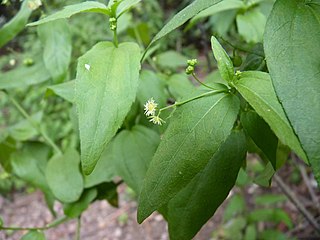
Chiropetalum is a plant genus of the family Euphorbiaceae first described as a genus in 1832. It is widespread across relatively dry regions of North and South America from Texas to Uruguay.
Angostylis is a genus of flowering plants in the family Euphorbiaceae, first described in 1854. The genus is native to northern South America.
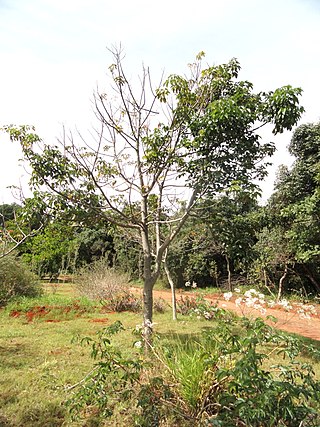
Joannesia is a genus of plants in the family Euphorbiaceae, first described as a genus in 1798. The entire genus is endemic to Brazil.

Maprounea is a plant genus of the family Euphorbiaceae first named as a genus in 1775. It is native to tropical Africa, Trinidad, and tropical Central and South America.
- Maprounea africana - W + C + S Africa, from Benin to Zimbabwe
- Maprounea amazonica - Colombia, Venezuela, N Brazil
- Maprounea brasiliensis - Brazil, Paraguay, Bolivia
- Maprounea guianensis - Trinidad, Panama, Colombia, Venezuela, French Guiana, Suriname, Guyana, Brazil, Peru, Ecuador, Bolivia, Paraguay
- Maprounea membranacea - Nigeria, Cameroon, Gabon, Equatorial Guinea, Cabinda, Central African Republic, Congo, Zaire
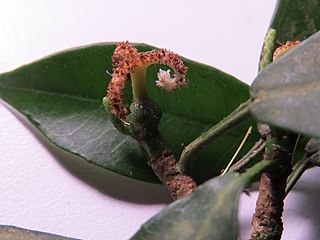
Algernonia is a plant genus of the family Euphorbiaceae first described as a genus in 1858. It is native to Peru and Brazil.

Bletia is a genus of about 30 species of orchids, almost all of which are terrestrial; some are occasionally lithophytic or epiphytic. It is named after Spanish botanist and pharmacist Don Luis Blet. The genus is widespread across Florida, Mexico, Central America, the West Indies, and South America as far south as Argentina.

Butia is a genus of palms in the family Arecaceae, native to the South American countries of Brazil, Paraguay, Uruguay and Argentina. Many species produce edible fruits, which are sometimes used to make alcoholic beverages and other foods. The name is derived from a Brazilian vernacular word for members of the genus.
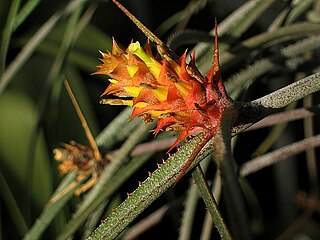
Acanthostachys is a genus of the botanical family Bromeliaceae, subfamily Bromelioideae. The genus name is from the Greek “acanthos” and “stachys”.
Cottendorfia is a genus of plants in the family Bromeliaceae. The genus name is for Johann Georg Freiherr Cotta von Cottendorf, German patron of the sciences (1796-1863).
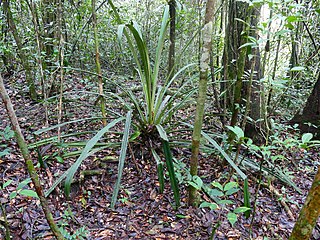
Disteganthus is a genus of plants in the family Bromeliaceae, subfamily Bromelioideae. The genus name is from the Greek “dis” (two), “steg” (covering), and “anthos” (flower). They are considered a primitive genus among bromeliads and are only found in terrestrial environments. Distenganthus has three known species, native to northeastern South America.
Mangonia is a genus of flowering plants in the family Araceae. The genus contains only two known species native to southern Brazil and Uruguay.
- Mangonia tweedieanaSchott. - Rio Grande do Sul, Uruguay
- Mangonia uruguaya(Hicken) Bogner - Cerro Largo in Uruguay

Bixa is a genus of plants in the family Bixaceae. It is native to Mexico, Central America, Caribbean, and South America, and naturalized in other places.
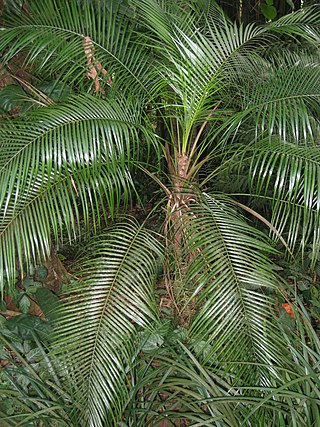
Syagrus weddelliana, also known as the miniature coconut palm or Weddell's palm, is a feather palm in the palm family.

Herreria is a genus of flowering plants native to South America. In the APG III classification system, the genus is placed in the family Asparagaceae, subfamily Agavoideae.
Bradea is a genus of flowering plants in the family Rubiaceae. It was first described by Paul Carpenter Standley in 1932 and is named after the German botanist Alexander Curt Brade. All 6 species are endemic to Brazil, hence the name of the type species.
Eriothymus is a genus of flowering plant in the family Lamiaceae, first described as a genus in 1835. It contains only one known species, Eriothymus rubiaceus. It is endemic to the State of Minas Gerais in Brazil.
Hoehnea is a genus of plants in the family Lamiaceae, first described with this name in 1939. It is native to South America, primarily southern Brazil and Paraguay.
Bahiella is a genus of plants in the family Apocynaceae first described as a genus in 2006. The entire group is endemic to the State of Bahia in northeastern Brazil, the state after which the genus is named.
Kerbera is a genus of plants in the family Apocynaceae first established in 1885. It contains only one known species, Kerbera eichleri, endemic to Brazil.












